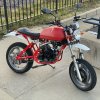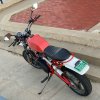I am happy to report that I have been able to put some miles on The Bride, and I feel it’s fundamentally a success.
I traced the CVT’s erratic behavior to excessive end play in the driven pulley shaft. A little shim washer was all it took to set it up properly; it is now working smoothly. I checked the Suzuki GN250 speedometer against my GPS, and it’s pretty much spot on. So, with those two last issues checked off, the Bride is essentially complete. There are a still a few cosmetic issues—the scarred sides of the tank being the most notable—but nothing that affects the function of the bike.

So, how
does it function? Well, about as well as I dared to hope it might when I started this project. The overall riding experience is peculiar, but easy and fun. It took a few miles to get a feel for pulling away from a stop, and remember that the rear brake is on the left handlebar instead of under my right foot. Once underway, the steering is easy and predictable—neither truckish nor squirrelly. I paid a lot of attention to the steering geometry early on, and despite the odd look of the trailing-axle fork, it works. The bike doesn’t nosedive under braking and the rear suspension is better than its limited travel and bargain-basement damper units would suggest. The heat shields kept my leg from frying at stoplights and all the electrical equipment worked as designed. The mirrors are high and wide, but very functional.
Fueling is good, too. For someone who has limited carb tuning experience, I got it at least in the ballpark. The engine starts from cold with just a moment of choke, idles nicely, and pulls through the rev range without hesitation. I credit a lot of that to the Nibbi carb. This is my third, and they’re a hell of a bargain for the price. I’ll definitely watch for a sooty exhaust and read the plug at some point, but for now I don’t see a pressing need to mess with it.
There are few niggles. The $35 seat feels exactly as comfortable as you’d expect from a $35 seat. The super-wide, non-folding ATC footpegs aren’t optimal. Their width not only complicates getting the bike in and out of the garage, but they also vibrate quite a bit on the road. Surprisingly, I didn’t feel much vibration through rest of the bike and the mirrors stayed clear.
Acceleration requires an eye on the tach. Whack open the throttle with abandon and the engine can exceed my self-imposed 4000 RPM redline by several hundred revs before the CVT’s gearing can catch up. The tach’s “max” memory function currently reads 4310 RPM—not alarming, but definitely approaching iffy territory for a cast flywheel. A little bit slower roll-on is all it takes to keep things in the safe zone.
My design goal for this bike was 50+ MPH. It gets up to 40 MPH effortlessly, and 45 is a bit more leisurely. I saw a GPS-indicated 47.5 MPH on my last ride. I’ve only ridden the bike in town so far; on a longer stretch of two-lane, I expect that 50 MPH is do-able.
Given the motley collection of components I started with, I’m thoroughly tickled with the result. I knew it would be a novel curiosity and a rewarding project. But it’s actually a genuinely usable, thoroughly street-worthy means of transportation, which I wasn’t too sure I could pull off.
















